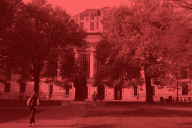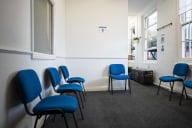You have /5 articles left.
Sign up for a free account or log in.

Source: Getty Images
For several years now, most counseling centers have been experiencing a continuous uptick in the number of students seeking services, as stigma over mental health issues lessens and more and more students come to college already on psychotropic medications.
But as September gets under way, many center directors say they’re seeing an even greater surge of walk-ins and appointments being made at the start of the academic year, with students making contact with counselors before they even leave for campus.
“It used to be where you’d ramp up during the course of the semester,” said Josh E. Gunn, president of the American College Counseling Association and director of counseling and psychological services at Kennesaw State University. “Now they’re coming in sooner. Our appointments seem to definitely be filling up earlier at the start of the semester than they used to, and I don’t know what’s causing that, honestly.”
But he does have a number of theories: Students seeing counselors at home want to make sure there’s no interruption in service. Anxiety, the most prevalent concern among students (41.6 percent of all students seeking help have anxiety), tends to affect students early in the academic year – and worries about the economy and job market still plague many first-year students coming from struggling families.
And then there’s the simplest, most obvious answer: counselors are being more active than ever in trying to get students in -- particularly through social media platforms – and maybe it’s actually working.
“I guess it’s kind of a catch-22, right?” Gunn said. “You go out there, you do things, but then you’re busier and it’s harder to get appointments.”
It’s happened at Appalachian State University too, said Dan Jones, director of the counseling and psychological services center there.
“I think word may have gotten out that if you want to get into the counseling center, you better get there early so you can get a slot,” said Jones, who is also president of the Association of University and College Counseling Center Directors.
The early surge in walk-ins (the counseling center does not take appointments for initial visits) has clogged up the waiting list, as anyone who can’t be seen at that moment must set up another time to visit. Then, once the waitlist thins out, counselors shift gears: the challenge becomes getting everybody in for the necessary appointments during the semester.
For the past three years, demand has exceeded capacity during the first few weeks of school, Jones said. Since 2009, initial interviews during the first three weeks have jumped by 66 percent. This year counselors did 17 more initial interviews than in 2012-13. (Those appointments are also increasing throughout the year, but to a lesser extent: by 50 percent in the first five weeks of the semester, and by 34 percent from August to August.)
Judging by discussions on a counseling listserv, it’s more than just a few centers seeing this pattern, Jones said – not just seeing larger numbers in the first three to six weeks than in years past, but larger than the rest of the year as well. Appalachian State had 20 to 25 people coming in daily during the first week of school, some of whom would have to wait for two or three hours, while six or seven others were turned away completely.
“A lot of universities are getting... numbers of people that are so huge, it’s even hard to accommodate all of them and get them seen in a short period of time,” Jones said. Which can be problematic when “most” colleges are telling parents during orientation to get struggling students to the counseling center as soon as possible. “We probably are a victim of our own success in some ways.”
AUCCCD’s annual survey reports how and why students visit counseling centers, though not when. But some other findings are informative: while student visits have increased, budgets have stayed flat. About one in five directors say the amount of psychiatric services on their campus is inadequate, and about a third of centers have a waitlist at some point during the year.
For many centers, flat budgets have been accompanied by flat hiring. While more centers are adding than losing staff, lots are struggling to meet demand regardless – and at a certain point, counselors just can’t see any more students. That’s likely part of the reason why visits have stayed stable for the past few years at the University of Tennessee at Knoxville, said Victor M. Barr, director of the counseling center there.
“We haven’t had a new staff line since 2009, and what I have come to understand is that when you max out for your staffing, that pretty much sets a limit at some point in students coming in,” Barr said in an e-mail. “Think about if your favorite market suddenly was hard to get through the aisles on Saturday morning at 9. You might seek an alternative.”
And when centers are forced to turn students away, there’s always a worry that they might not come back.
“It’s always possible that somebody’s built up their nerve to come in and may feel rejected in some way…. From time to time, we do hear stories,” Jones said. “That’s not what we want to happen.”
Mark D. Thompson, director of the Colgate University counseling center, has been hearing from more students and parents during the summer looking to ensure continuity in care during the transition to campus. Right at the beginning or even before the semester starts, these and returning students who already know the lay of the land are making sure they’ll get in.
“Because the demand for services is so high, the longer our students wait to schedule, there may be a delay in getting them in,” Thompson said in an email. “So, those students who are aware of this tend to call sooner, to not have to deal with any delay in meeting with our staff.”
Wright State University’s walk-in system has “consistently” had students come in before the start of the semester, and while demand for service has remained flat for the past two years and these first couple weeks of school, enrollment has been declining. Prior to 2011, demand had increased 8 percent.
“So, it may be a net increase when based on the percentage of students on campus receiving services,” Robert A. Rando, director of counseling and wellness services at Wright State, said in an e-mail.
Enrollment at Appalachian State, on the other hand, is on the rise – and there and at other centers like it, which typically see about 10 percent of the student body at least once, one would expect a directly related increase in visits throughout the year. But that doesn’t entirely explain the early surge, Jones said.
“We have been having such increases each year, even before the increase in students coming in earlier in the semester,” he said. “The ‘rush’ at the beginning of the year seems independent of enrollment increases.”








